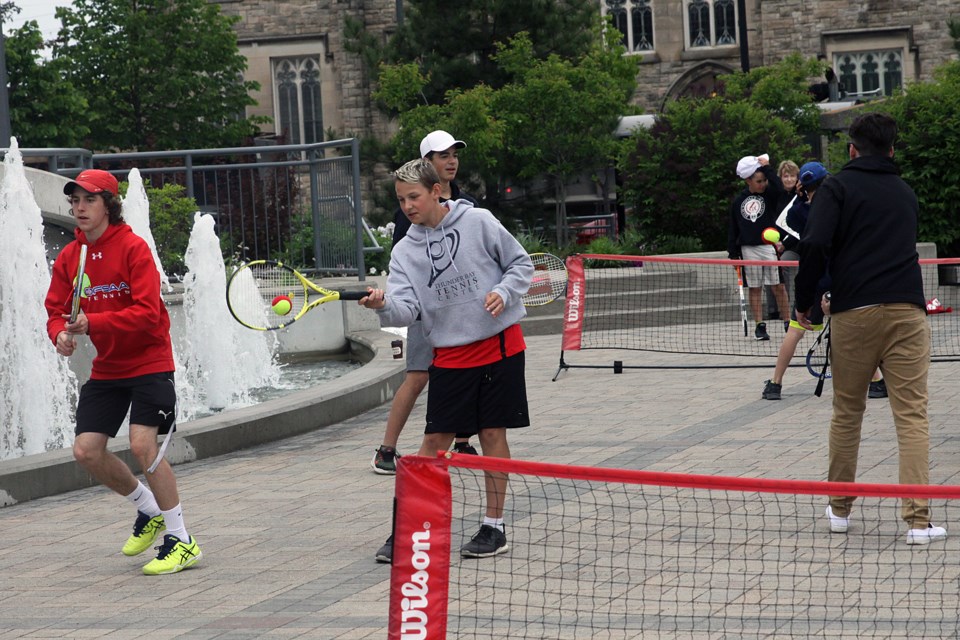THUNDER BAY – The process to develop the city’s proposed indoor turf facility has kicked off, with tennis and other racquet sports brought inside.
The multi-sport centre, a potential legacy defining project for this fledgling term of Thunder Bay city council, received in-principle support to proceed with a metal building structure at Chapples Park, including a six-court indoor tennis component. That decision, which still needs to be ratified at a future city council meeting to be finalized, would approve $4.25 million for design and engineering work to get the project shovel ready.
Thunder Bay mayor Bill Mauro, who has championed the project through the first six-plus months of his term, said a new facility makes sense.
“This is a community building project. It is why people will choose to live here. It is why people will maybe choose not to move away,” Mauro said. “You don’t build a community by having very good roads.
“That’s not what builds a community. That’s not what makes people want to live somewhere, because their roads are great.”
City administration had prepared a report, recommending the estimated $30 million indoor turf facility be located with Chapples Park and use a conventional building structure, rather than an air-supported dome. While a vision for tennis was included in the city’s long-term recreation and Chapples Park master plans, the component was not initially part of the first phase of the project and had been identified as an opportunity for a future addition.
Demand for indoor sports facilities has heightened following the November 2016 collapse of the privately-operated Sports Dome, which eliminated the availability of an indoor turf field surface for many user groups, including soccer, football and ultimate frisbee. As well, the closure and subsequent repurposing of the former bubble on Confederation College campus has left no indoor tennis courts remaining in Thunder Bay for the last two winter seasons.
Thunder Bay Community Tennis Centre president David McCallum, who said the club serves more than 2,000 tennis players across the region with a membership of more than 480 last year, lobbied for racquet sports to be included immediately.
“We feel that indoor racquet sports or indoor tennis needs to be a part of this community,” McCallum said. “Any indoor tennis for us would be a benefit for our community and we are prepared to be part of that.”
Adding the six-court component, which increased the development cost by $650,000 to $4.25 million, was narrowly supported by council with five of the nine members present voting in favour. In the long-term, including tennis could add as much as $8.2 million to the total capital cost of the project.
While the need for a facility was widely acknowledged by councillors, some expressed doubt in their belief of the city’s ability to come up with the money.
“I cannot go forward unless I know where the end is. This is just spending $4.25 million that might not go anywhere and I have a problem even spending that kind of money,” Coun. Rebecca Johnson (At-Large) said, relating this process to the city’s unsuccessful pursuit of an event and convention centre earlier this decade.
“I don’t know where we’re going to get the dollars. This community doesn’t have the dollars.”
Johnson, along with Coun. Brian Hamilton (McKellar) and Coun. Peng You (At-Large), voted against the project.
In the report, administration provided a brief outline of some financing options. Council earlier this year had already allocated $4 million from the Renew Thunder Bay reserve fund to a newly created, standalone indoor turf facility reserve fund and committed the city’s estimated $1 million share of municipal accommodation tax revenue from this year. Thunder Bay has received $6.9 million from Ottawa this year as one-time enhanced federal gas tax funding, which would be used as project financing. A breakdown of multiple long-term debenture options was also given.
Mauro, who noted the city could have as much as $15 million through those funding sources without raising taxes, insisted there are options available.
Council also voted to identify the project as a priority for the Investing in Canada Infrastructure Program, a federal and provincial funding program that is expected to include a recreational component later this year. Administration was also directed to proceed with a second stage funding application to the Northern Ontario Heritage Fund Corporation.
“There’s other money out there. When I hear the language that we don’t have the money, actually we do,” said Mauro, who added he would be concerned about taking on debt to finance the project. “We just have to decide what we’re going to spend it on. We just have to decide what our priorities are.”
In addition to ratification, council is also expected next month to decide on a proposal from Mauro to establish a special committee to review and make recommendations about the project’s direction.
City officials previously said the earliest the facility could be operational would be in late 2021, if construction starts next summer.
